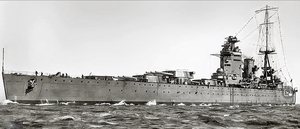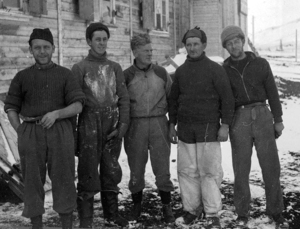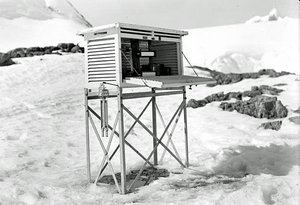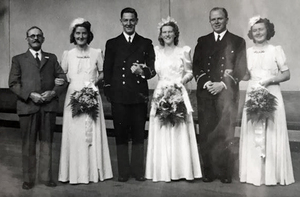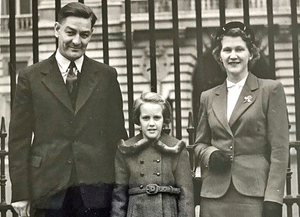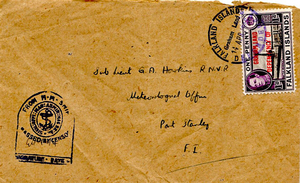HOWKINS, GORDON ARTHUR
1919-2017 from England
sub-Lieutenant RNVR, MBE, meteorologist, member of Operation ‘Tabarin’ team and Falkland Islands Dependencies Survey (FIDS) was born 3 October 1919 in Mexborough, Yorkshire, England, His parents were Arthur Joseph, and Ethel Maud Howkins His father was a retired coppersmith. Gordon Howkins attended Mexborough Grammar School on a County Major Scholarship for four years. He then went to King's College, London, also on a four-year scholarship, in 1938 to study maths, physics and chemistry. At the outbreak of World War II in September 1939 he volunteered for pilot training in the Fleet Air Arm. He was called up in June 1940 after taking his final university examinations, but in the event, he was trained as a meteorologist at Lee on the Solent.
Howkins joined his first ship at Scapa Flow - the battleship HMS Rodney - at the time she was involved in the hunt for, and sinking of, the Bismarck. Howkins eventual destination was the Falkland Islands to join the RN wireless station as a meteorological assistant – providing weather forecasting for RN ships in the South Atlantic and South Pacific.
Howkins recalled his time in the Rodney when she was chasing the Bismarck
Passengers were asked if they would like to have a battle station and I ended up in the cordite handling hoist in-between the cordite store and the hoist of both guns. I believe” Rodney” fired up to 400 16” shells - one salvo took out the control tower of the Bismarck - although badly damaged she did not sink … Fortunately, Rodney received no direct hits and had only 15 minor casualties, one being me because I slipped on the greasy deck [and] caught my thumb in a bulkhead.
Howkins then travelled to Nova Scotia, in the Rodney, which was escorting a convoy. He joined the transport ship Lady Drake which was travelling to the West Indies. At Trinidad he joined an RFA tanker that was supporting the cruiser squadron in the South Atlantic. In October 1941 he arrived in Stanley and joined the HMS Pursuivant (located at Church House, in Stanley) as part of the meteorological staff. The recording equipment was located at the Agricultural department and was checked every three hours, before being broadcast by radio to HM ships in the South Atlantic. He worked in the Met. Office for nearly eighteen months, and during this time he met his future wife Olga Annie King. They became engaged in June 1943.
Howkins then returned to the UK for officer training. He went initially to the Royal Naval College, Greenwich, and then to the Naval Met. Branch, located in Berkeley Square, in London. Howkins was then approached by a senior naval officer and asked: ‘
Would you like to volunteer for a top-secret expedition? All I can tell you about it is that it could involve two days in the Falklands.’ So, I said, ‘Thanks very much, I'll go!
He travelled to Avonmouth and joined the Royal Mail ship Highland Monarch, as the meteorologist in the ‘Operation Tabarin’ team. On arrival at Montevideo, he transferred to the Fitzroy, for the five-day trip to Stanley. During his stay in Montevideo Howkins bought clothes and materials for Olga for their eventual wedding day. He arrived in Stanley on 26 January 1944.
Howkins recalled years later that:
‘We travelled [South] in the Fitzroy, … Marr and Flett and one other person travelled in the WilliamScoresby, and the rest of us were in the Fitzroy … [which] had been chartered from the Falkland Islands Company to accompany the William Scoresby down South. We arrived in Deception Island … very early in February. [2 February 1944] There was no ice at all; it was all clear, clear sea all the way down. The rest of the party were there for only two or three days while we landed our part of the stores. In fact, some of them were still I think in stores marked for the other base....and we never saw them! But we were very fortunate really because the whaling accommodation was in perfect order. There were two large dormitories … They had been sealed up, and the snow hadn’t got in. All we had to do was to find some bedding and settle down. We had no hut to build, unlike the base at Port Lockroy.’
Thus, Howkins became the first meteorologist to work at Deception Island. The team consisted of a meteorologist, a wireless operator, a cook, and a handyman. After about 3 months on Deception Island, he developed appendicitis, but base members Flett and Matheson took care of him until he recovered.In February 1945 Howkins was posted to the naval base in Stanley as one of the two forecasting officers.
On 3 April 1945 he married Olga Annie King, at Christ Church Cathedral. Olga’s parents were Alfred Bertram King 1888-1946 and Mabel Annie Sarney 1895-1981. The wedding reception was held in the Ship Hotel [later the Upland Goose hotel]. Olga’s grandfather was a master builder and cabinet maker and he had come down from England to help build the first Town Hall in Stanley.
Howkins was due to be posted to the Far East, but in the event, he was posted to the Naval Air station at Stretton, Cheshire. He recalled:
Then I got a signal from Admiralty to say I was to attend a meeting in Victory House with the Air Ministry … The purpose of the meeting was to decide whether the Air Ministry would take over Port Stanley and in particular the Naval Met station … because a government decision had been taken that the Navy wasn’t to run any shore stations. The Air Ministry Met Office would run all the shore stations. Well I told them what I could about living there and the conditions that were there and so forth and they decided, almost a bit reluctantly, that they would in fact take it over … Senior Officer Johnson, who was chairing the meeting – he was in charge of the Met Office – said almost despairingly ‘Well we had better do it but I don’t know how I am going to man it.’ And jokingly I said, ‘I’ll go for you.’ and I forgot about it immediately. About a fortnight later I had a letter saying could I get into contact with the Civil Service Commissioners who would like to see me before I took up service in Port Stanley in the Air Ministry. I said, ‘How do we get out of this? ‘At the time we were living with my parents (Arthur and Ethel Howkins) in Horsforth, near Leeds, talking about modifying the house so they could have a place for ourselves there, and I was back at university. We realised then that [our daughter] Jeanne was on the way … We decided that we would accept the offer. So that’s how we ended up back in Port Stanley working for FIDS.
There was considerable confusion as to who was responsible for the Met. Office in Stanley – the FIG? or the Royal Navy? Or the Air Ministry? or FIDS? The Governor Miles CLIFFORD insisted that he was in charge and Howkins should be seconded to his staff. In November 1947 Howkins wrote to Brian ROBERTS at the Foreign Office to express his frustrations and concerns:
It is beginning to look as though the FIDS Met. will be in the same rut next season, as it has been in the past. It appears that my suggestion about observers has brought results - the new men are apparently neither trained met. observers nor are they to be given any opportunity to attend the Met. Office Training School. This is bound to restrict the standard of observing, which after all is the foundation of all the met. work, and incidentally must costing the FIDS rather more than is necessary if they continue to use ex-Naval officers as observers … Frankly, I think that much more useful work would be achieved if we were allowed to set up the existing stations efficiently, before other projects are tackled. I feel strongly that we shall achieve little until there is a better co-ordinated administration … it is essential that the whole Met. organisation, both in Stanley and in the Dependencies, should be recognised as an entity and administered as such.
Howkins was summoned back to London (he flew back via West Africa and Beirut in a Lancaster bomber) and at a meeting at the Air Ministry it was formally agreed that he would be seconded to the Governor, to manage and organise the Falkland Islands Dependencies Met Service.
I received a letter from the Air Ministry offering me a post in the Falkland Islands for 3 years to take over the Naval Met station, set up a radiosonde station for the Islands and working under the Governor to start a met forecast for the Islands and for the whaling factories working mainly from South Georgia …My instructions from the Director were to establish the radar/radiosonde station as a first priority and to run the station as a whole but also as required to provide advice to the Governor on met. matters affecting Antarctic bases.
The team consisted of two forecasting officers with five assistants - two of whom were Falkland Islanders.
Between 1950 and 1955 Howkins visited almost all the FIDS bases sailing in the John Biscoe. He set up and visited observation stations at Goose Green, Fox Bay, Pebble Island and Port Stephens. During his time in the Falklands Howkins was fully involved in the life of the community. He served on a number of committees – the wireless communications committee, the broadcast committee, and the Labour Board. Gordon and Olga had three children in the Falkland Islands - Jeanne Elizabeth, born in 1947, Sheila Mary in 1951, and John David in 1955. Sheila and John were both baptised in Christ Church Cathedral.
Howkins made a number of perceptive observations about the weather condition in the Falklands:
About 1950 we established an anemometer on Sapper Hill and proved that the wind speed was almost always 25% greater than at the office (which itself had good exposure). The average wind speed in Stanley is about 15 knots and it is rare to get gales or very strong winds for that matter. Consequently, it is ideally suited for wind generation of electricity
Howkins eventually did three tours of duty in the Falklands – each lasting three years. The family then decided to return to the UK permanently because their eldest daughter Jeanne was now nine and there were no facilities in the Falklands for anything approaching secondary school standard. The Howkins family left the Falklands in 1956.
Howkins was still seconded from the Air Ministry, so when his secondment ended, he took up a post in the Air Ministry as a Senior Scientific Officer. For three months he was at Stanmore Training School being brought up to date, before being posted to Heathrow airport as an upper air forecaster for three years, later becoming the Senior Forecaster for three years. He was then sent to Bracknell (the Met. Office headquarters) forecasting upper air winds for the North Atlantic flights. He was made secretary of the purchasing committee for the acquisition of new computers that were to be used in forecasting.
Not knowing anything about computers. I remember the assistant director in charge of that section sent for me and said: ‘Do you know anything about computers?’ I said ‘No.’ He said, ‘Well you will soon learn.’ … I was eventually promoted to Assistant Director for Data Processing.
Gordon Howkins was awarded the Coronation Medal in 1953 and the MBE (for services to the Falkland Islands Dependencies Survey) in 1956. He retired from public service in 1979. He planned and had constructed a bungalow, “Oakdene” in the rear garden of their family home “Northwood” in South Ascot. Then in 1988 the Howkins left “Oakdene” and moved to a bungalow in Worlaby, S. Humberside which was substantially modified by Gordon Howkins. He then proceeded to plan and construct another bungalow “Greengarth” in its garden. In 2001 Gordon and Olga Howkins moved to Brigg where yet another bungalow was also extended and modernised.
Olga Howkins, aged 93, died 10 September 2017 in Scunthorpe General Hospital, North Lincolnshire. Gordon Howkins had a heart bypass operation in 1983, but was generally in good health until he died, aged 98, on 9 October 2017 at his home in Brigg, North Lincolnshire, England. The ashes of Gordon and Olga Howkins were returned to the Falkland Islands and were scattered at Cape Pembroke in December 2017.
The Howkins Inlet (73°40′S 60°54′W) was named by the FIDS for Gordon Howkins. It is an ice-filled inlet which recedes southwest for 11 km between Cape Brooks and Lamb Point, along the east coast of Antarctica. During 1947 it was photographed from the air by the Ronne Antarctic Research Expedition under Finn Ronne, who in conjunction with the Falkland Islands Dependencies Survey (FIDS) charted it from the ground.
External links
Comments
Revisions
October 2022 Biography first added to Dictionary
